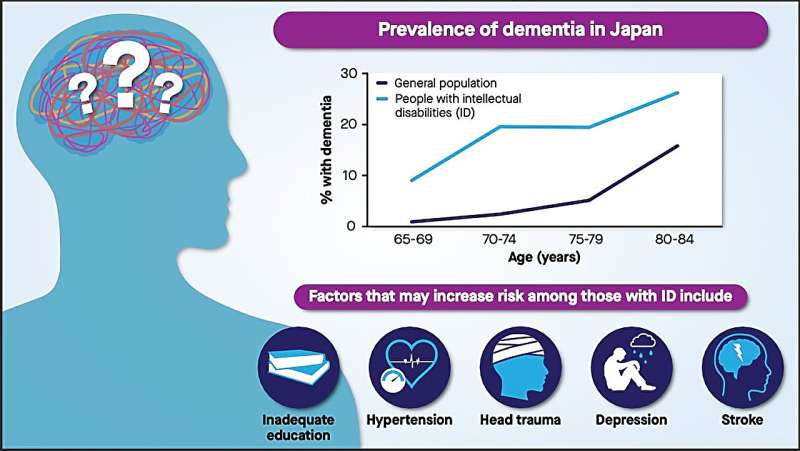
Both genetic and acquired factors contribute to the onset of intellectual disability (ID), and people with ID are presumed to be at a higher risk of developing dementia. It is also understood that a lower cognitive reserve–thinking ability gained via learning and conscious mental activity–increases the risk of dementia in the general population.
Given the likelihood of a shorter education span and a lower intellectual capacity, it is speculated that dementia is more prevalent in people with ID. However, the prevalence of dementia in people with ID without Down syndrome (DS) relative to the general population is unknown, and the risk factors influencing the risk of dementia aren’t thoroughly established.
Recently, researchers uncovered the prevalence of dementia and identified the risk factors that can lead to dementia among people with ID in Japan. The team was led by Professor Shintaro Takenoshita, Assistant Professor in the Department of Neuropsychiatry at Okayama University Hospital, Japan. Their findings were published in the journal Alzheimer’s Research & Therapy.
“Diagnosing dementia in people with ID is difficult owing to the mixed effects of innate cognitive decline and the cognitive decline that occurs over time due to dementia. However, it is quite possible to diagnose dementia if cognitive and lifestyle functions are assessed chronologically based on information from family and other support persons. We believe that even in persons with intellectual disabilities, dementia needs to be properly evaluated,” explains Prof. Takenoshita regarding the group’s motivation to pursue the study.
The team surveyed the severity of ID, educational history, and comorbidities across 1,831 participants in residential treatment facilities spread across Japan. The relevant data was collected by interviewing caregivers of all the participants, and a direct examination was performed–using clinical criteria for dementia and neurocognitive disorders–for participants suspected of having cognitive decline.
Emphasizing the report’s key findings, Prof. Takenoshita says, “We found that 6.44% of the participants were diagnosed with dementia. Furthermore, our analyses revealed that dementia was more prevalent in younger people with ID compared to the general population. Lastly, we pinpointed seven factors with significant links to dementia. These were hypertension, depression, stroke, age, severity of ID, duration of education, and traumatic brain injury.”
These findings are expected to enable better screening for dementia and improve the support and medical care for people with ID. It is important to note that some of the risk factors are modifiable. Therefore, depending on a patient’s profile, providing adequate education, preventing head trauma and stroke, and making hypertension and depression medications readily available could be the first steps in preventing the onset of dementia in people with ID.
“This is the largest study that explores the prevalence of dementia in a population with ID. Additionally, we minimized the study’s bias by surveying participants from a wide geographic range. This implies that the risk factors we identified are reliable targets for designing interventions intended to minimize the risk of dementia in people with ID,” explains Prof. Takenoshita.
Moving forward, Prof. Takenoshita is confident that future studies can build on the scope of his team’s work. As the understanding of dementia evolves, public health recommendations in medical policies can be developed specifically for people diagnosed with ID. Along these lines, the insights on the modifiable risk factors can potentially help catch the onset of dementia and ensure that people with ID do not miss out on treatment or interventions that are readily available.
More information:
Shintaro Takenoshita et al, Prevalence and modifiable risk factors for dementia in persons with intellectual disabilities, Alzheimer’s Research & Therapy (2023). DOI: 10.1186/s13195-023-01270-1
Journal information:
Alzheimer\’s Research & Therapy
Source: Read Full Article
